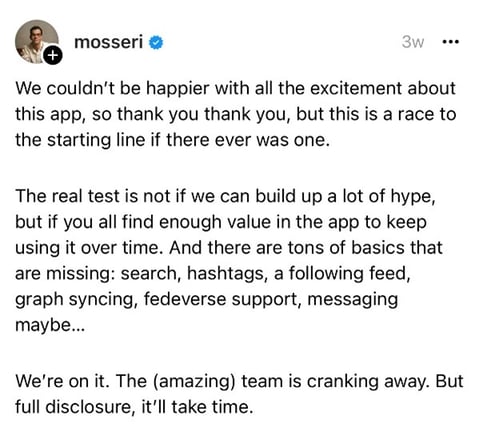Is it time to change the channel for your farmer marketing strategy?
How to navigate the changing social media landscape

First came BeReal, then came Threads. The social media landscape isn’t static. New platforms are emerging and existing ones are rebranding – we’re looking at you, X. As new platforms emerge, the world of social media continues to spin on its axis. If you think it can be difficult to navigate these shifts from a brand perspective for your farmer marketing strategy, you’re not alone. Social media marketers across the world are trying to figure out how Threads works and what Twitter’s rebranding to X means for them.
Adding to this evolution as launches and rebrands occur, existing platforms often change their UX to compete with other sites and apps – TikTok vs. Reels vs. YouTube Shorts, for instance. It can be tempting for marketers to jump on board the next social media trend to keep up with the social media Joneses. When it comes to successful social media marketing our advice to marketers is that more isn’t always more. What works for one brand or farmer marketing strategy may not be the recipe for success for the next. In this post, we’ll examine some cautions and recommendations for navigating this dynamic landscape.
HAVE A "STRATEGY" IN PLACE
Threads has been at the forefront of social media marketers’ minds since it launched in early July. Should your brand invest in this new space? When your company has made the decision to test out any new platform, it’s important to have some guideposts in place to serve as your initial “strategy” – emphasis on initial, because it’s going to change. As the platform updates and changes, so will your strategy.
As Jack Appleby, author of the marketing e-newsletter Future Social said in a recent LinkedIn post, “Strategy is your theory on how to win. And before you launch a single tweet or a single marketing initiative, of course you should have some strategy, even if a brand-new social network launched 5 minutes ago! It’s your initial strategy! And you, a smart person will adapt your strategy as you learn and grow and discover.”

It’s ok to not have everything figured out when a new platform launches. In many cases, the creators of the platform don’t even have it all figured out, as was apparent from Instagram CEO Adam Mosseri’s comments a few days after the Threads launch. Having a few “launch” guidelines for joining a new platform will help you get up and running for the time being.
For example, your social media launch plan could include:
-
Keep Your Goals in Mind. Your social media strategy, just like other facets of your marketing strategy, should help your business achieve its overall marketing goals and objectives. If you already have social media channels, think about where the new channel fits in that mix, and what it adds. As you expand to a new channel, keep your overall goals and objectives in mind.
-
Brand Guidelines. Even on a new platform, your brand should still look like the brand your audience is used to seeing in other channels. Of course, there will be opportunities to try out new things and adjust your tone or voice slightly, but those who know you should recognize you even on a new channel. Keeping the foundation of your image and your content true to the brand will help you set the tone for this new social environment.
-
Tone. No matter where your brand is present, it’s important to maintain your voice. With each new social media channel, it may be appropriate to adjust your tone or the mood of content to fit that environment. But while each social platform has its own distinct tone, your content should stay true to the brand voice.
-
How you interact with your audience on other channels should stay consistent even when launching your brand on a new platform. Of course, that interaction is going to look a little different depending on the nature of the channel, but how often you interact, how quick you are to respond, and what type of interactions you have with your fan base should remain the same.
The exact details of the launch strategy are up to your team and brand, but it’s important to recognize these non-negotiables, which must be in place before you’re ready to go. Having consistent guidelines in place should help make the transition into a new social space smoother.
LEVERAGE AVAILABLE RESOURCES
Your brand’s social strategy should be realistic to its resources. When you start posting on new channels, repurpose content where applicable to maximize the graphics and assets you already have available. This is particularly handy for small social teams.
Don’t be afraid to test things out on a new platform first to see how things work. If you want to learn about the new channel but aren’t ready to launch your brand, make a personal account and use yourself as the guinea pig. Depending on your brand guidelines and voice, it may make sense to do it right on your brand’s feed, like American Eagle did when the brand tested Threads’ limits to discover the maximum character count for a post.

CONSIDER THE VALUE TO B2B
For your social strategy to succeed, you need to go where your audience is. Without your target audience, no matter how strong your message, you won’t see the desired results. At R+K, because most of our clients fall under the agriculture vertical, we’re often looking at things from a B2B perspective.
The success of B2B business is built upon finding quality leads instead of a large quantity for brand awareness. For the most part, agricultural businesses fall into this category. B2B businesses often have an opportunity to stop, take a beat, and evaluate the benefit of launching on another social media platform, as their business is built on relationship building and demonstrating the ROI of their product or service.
Also, because ag is a niche audience, having a widespread social media presence isn’t always the best approach. It’s important to recognize your audience and be present where they spend most of their time online. Brands that have a stellar strategy on Facebook, X and YouTube might find they have as much or more access to their audience than the brand who is on all of those plus Snapchat, Pinterest, TikTok, etc.
TRENDS COME AND TRENDS GO
For B2B brands, stepping back and evaluating the next move before taking on a new social media channel can be beneficial simply for the fact that not every new social media channel is going to be a success and take off right away. If you can afford to wait before creating a new profile on the latest network, you’ll have the luxury of observing how new users are receiving the channel. This will help you determine if it’s going to be a good fit for your business and brand and potentially avoid wasted time and resources.
EXAMINE YOUR STRATEGY REGULARLY
Because the social media landscape is constantly changing, it’s important to re-evaluate your social strategy on a consistent basis. Setting aside this time will help you determine if existing channels are serving their purpose and helping you meet your business goals. Research and observe the general landscape of your social feeds and engagements. If it appears that your audience is no longer engaged with a given social platform, you may want to scale back investment in that channel or even step back entirely if it no longer aligns with your overall strategy.
Overall, not every social platform is going to be right for every brand’s farmer marketing strategy. It’s ok to stick to a few and do them well rather than spread yourself too thin across a variety of channels. The barrier to entry on social media is low, as most channels allow businesses to create and run accounts for free from an organic social media perspective. Wise marketers pivot and change strategy as the audience and goals change.
To join our conversation around brand social media strategy, for now, you can find us on Facebook, X, Instagram and LinkedIn. We’re also learning how to use Threads, so stay tuned because you may see us pop up there soon!
If you have questions about your social media strategy, we can help. Drop our Business Development Manager a note.
Never miss an article.
Get the latest sent straight to your inbox.
Related Articles
Marketing strategy is the road map to success
...

